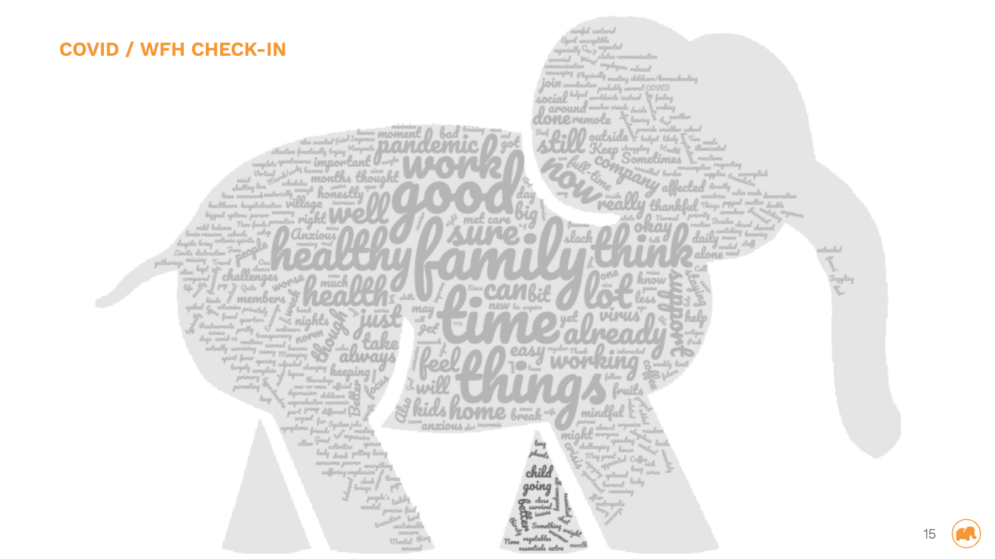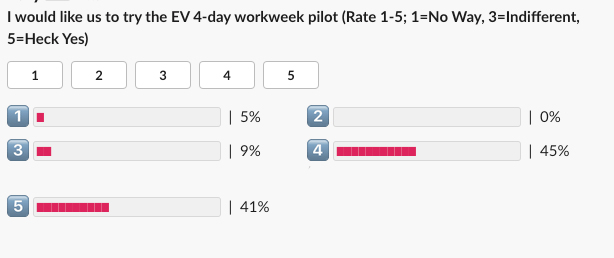Why did we do it? Covid? WFH Burnout? Productivity boost? Morale? yep.
At Elephant Ventures, we regularly reflect on the health and performance of the company. We are Innovators and believe in iterative agile progress. Just as much as this is how we approach our customers’ needs it is also how we approach our own business and internal processes. Folks that come to Elephant often note that we have a refreshing willingness to look at what is broken or sub-optimal and change it for the better (sometimes it takes a few tries).
We are data nerds., Back in March after a few months of debate, we didn’t like where the covid stats were going. As a result, the first week in March, we had already given notice at our office and converted to full-time distributed work (work from home) for the foreseeable future.
In the current covid pandemic climate, we wanted to make sure we were still operating optimally. We started to look at our team and where we might optimize for productivity to make sure we were able to keep Innovating efficiently for our clients. We thought folks would recoup time and see increased productivity from the removal of their commute time, but in general we didn’t see as much of a boost as we would have liked.
We began to investigate where we might gain further improvements, and we came to understand that some of our Phunts (we lovingly call ourselves “Phunts”) were combining their work day to include child care, short order cook, and distance learning IT support and proctor. In general for those folks their days were extending, and days were a mixture of lots of short, interrupted work periods. Due to the mental load of context switching, we know from our other experiments that that type of work pattern induces significant inefficiency and our team was extending their hours even more to keep productivity the same.
days were extending and were a mixture of lots of short, interrupted work periods
With a backdrop of that interrupted work, and the confinement from covid, some of our other Phunts were struggling to preserve barriers and balance between work and life. We were seeing signs of folks burning out, or struggling with morale.
Getting to the 4-Day Work Week
We’d long observed 20 - 30% productivity boosts from our Manila team that works a 4-Day Work Week. With our US conversion to fully distributed work, some of the barriers to converting to a 4-Day Work Week in the US were removed, like client insistence of staff being on-site in NYC.
A few folks had 3-day weekends scheduled here and there in the spring. Then the 4th of July holiday had the entire US team off for an extra day, and the difference we noticed in productivity was profound. After 3-day weekends, our team came back with renewed focus and energy and we had a great week.
After 3-day weekends, our team came back with renewed focus and energy and we had a great week.
We then did for ourselves what we would do for our clients. We did an all-hands retrospective, evaluated what was working about our distributed setup and what wasn’t and got really excited at the prospect of the 4-day Work Week.

Our team was the most excited about starting early (okay, so maybe ‘excited’ is not applicable to the early part but objections to the early start quickly dissipated). Having optimal, prolonged, deep-work cycles at the start of the day when our brains are most effective and increased overlap with our Manila team. Functionally, as we discussed what we would need to do to make it work, we realized we would also need to extend a bit in the evening, and to try to encourage a focused break for the entire team for 1 hour where we strongly encourage group lunch zooms to help us maintain our social bonds across the team. You just can’t work 10 hours non-stop and be efficient, you need a brain break and a reset somewhere past the halfway point.
You just can’t work 10 hours non-stop and be efficient, you need a brain break and a reset somewhere past the halfway point.
As we discussed the 4-Day Work Week in more depth we discussed three key KPIs:
- Maintaining project and work best practices
- Monitoring our 40-hour weeks to make sure we weren’t pushing excess hours on employees
- Making sure service to our customers was maintained or improved
We also discussed how we could support our company culture and how to make sure the PHUNTS were really happier with the new schedule. We are looking at how best to evolve our meeting efficiency as well. We are leveraging the PAL concept (Purpose, Agenda, Limit), shortening meetings where possible, fitting them into a 3 hour band dedicated to meetings every day (protecting our mornings for deep work), showing up and leaving on time and removing members that are optional. We are looking to PAL to further compress our meeting times to get the next increment of productivity injected into our Dependable Innovation™ mojo.
Overall, we all are excited to have a fixed 4 days to focus and do our best our work and then 3 days of downtime to reflect, engage with our personal lives and families and to then come back Monday with renewed intensity.
Timeline of how we went fully remote then decided to do a 4-Day Work Week pilot:
7 YEARS AGO: About 7 years ago, we launched our Manila office for Elephant Ventures, and then also through our Venture Development studio (we call it ‘The Foundry’) launched another company that operates as a fully remote testing and quality engineering services firm, and it’s been operationally covid-proof from the start as a result. Between those two initiatives we have learned a TON about creating thriving culture and executing efficient work with distributed teams. If you don’t have a time machine, and can’t go back 7 years to start prepping for the distributed work model, don’t worry, there are some great resources out there for encouraging productivity and positive culture in a distributed team. I would recommend you start there, and if you are feeling good about distributed teams, then tackle the 4-Day Work Week. The 4-Day Work Week is not a SOLVE for poorly functioning distributed teams.
The 4-Day Work Week is not a SOLVE for poorly functioning distributed teams.
Back in March, covid numbers looked really bad, as we are a data-driven Innovation firm afterall, we decided March 9th, to let people optionally WFH, then on March 12th we got clarity from data and officially closed our office and gave notice to our landlord to optionally terminate our lease.
June 10th: We formally moved the last of any remaining things out of our offices, with no plan to return to office work.
Late-June: We decided in to learn more about the 4-Day Work Week and think it through operationally in the US. you may need to take more time in the evaluation and planning phases than we did, remember, our Philippine team has been on a time shifted 4-Day Work Week for ~5 years already so we definitely weren’t coming from a cold start.
Early-July: We announced to our team that we were entertaining a 4-Day Work Week pilot in to get folks thinking about the pilot and what it might mean and if it would work for them.
Mid-July: We did a formal ‘Ask me Anything’ type of all hands meeting , to share our more detailed 4-Day Work Week Implementation Plan Document, and open it up for questions and tweaks.
3rd-Week-of-July: We opened up the decision to pilot or not to the US staff, and we took a poll to decide if we should proceed and saw overwhelmingly positive results. While 86% in favor or ‘Heck Yes’ was a GREAT response, we weren’t properly prepared for the question of “What if we get a ‘no way’?” You should definitely be prepared for the fact that for some of your existing staff that there will be logistical reasons that they simply can’t do a 4-Day Work Week. We had a few folks unexpectedly be definitively opposed to the pilot, take care to think through how you’ll handle the exception cases for people that don’t want to, or can’t do the 4-Day Work Week.

take care to think through how you’ll handle the exception cases for people that don’t want to, or simply can’t do the 4-Day Work Week.
- When then decided to hold the pilot for 1 month, starting August 1, and then if that went well to pilot for a 2nd month in September when kids were back to school. August will be to determine if we can successfully make the change without client, productivity or morale impact. September will be to evaluate if that is sustainable when school resumes for our parents on staff.
- We notified our clients on July 20th of the Pilot. You can check out the template we used here.
- August 1st, we launched headlong into our pilot, stay tuned for part 3 in the series, where we will record our week one observations and learnings to help you in your pilot.
Check back soon for Part 2 in our series: “Planning resources from our launch of a 4-Day Work Week pilot.”
Elephant Ventures is a Data-Driven Innovation and Transformation Company. Our data-to-decision accelerator services and software help your team to rapidly capture value from data driven decisions.










